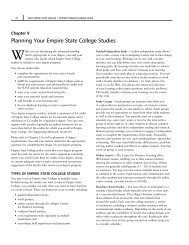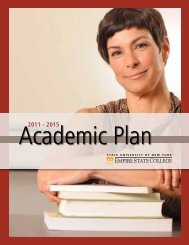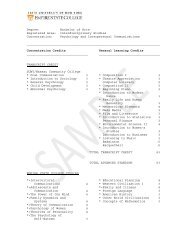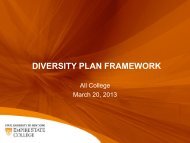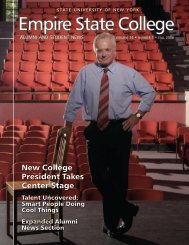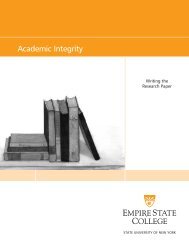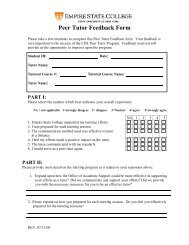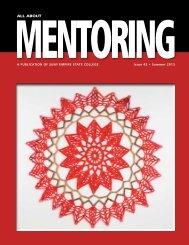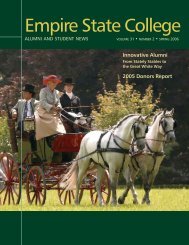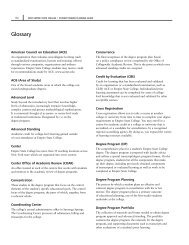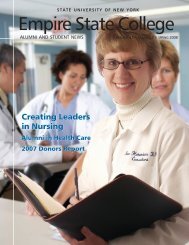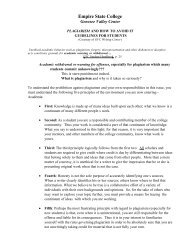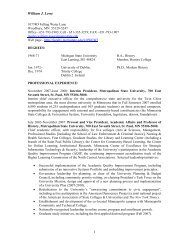All About Mentoring Spring 2011 - SUNY Empire State College
All About Mentoring Spring 2011 - SUNY Empire State College
All About Mentoring Spring 2011 - SUNY Empire State College
Create successful ePaper yourself
Turn your PDF publications into a flip-book with our unique Google optimized e-Paper software.
15<br />
their learning activities. In the case of digital<br />
media studies receiving significant revision,<br />
the largest problem we face is not in helping<br />
students master new tools and incorporate<br />
them into their learning; it is, rather, the<br />
necessity of helping instructors prepare to<br />
teach courses that include new and social<br />
media. More often than not, the issues<br />
that arise are related to the assessment of<br />
learning within this new media environment.<br />
Student transgressions with regard to the<br />
use of the media are rarely technical. They<br />
often occur due to the blurred lines between<br />
ethical uses of media, intellectual property<br />
rights, and the tension between “common<br />
practices” and “academic expectations.”<br />
One challenge we face is in analyzing,<br />
evaluating, recognizing and implementing<br />
the appropriate digital media tools and<br />
technologies for teaching and learning<br />
in higher education without succumbing<br />
to the appeal of the shiniest new trend<br />
of the moment. Another is assessing the<br />
effectiveness of these degrees of literacy,<br />
ensuring that they are not taught to the<br />
detriment of deep learning in meaningful<br />
topics, and providing learning experiences<br />
that are rich in opportunities for research<br />
and the development of critical thinking. A<br />
key strategy for encouraging digital media<br />
literacy is to place a strong emphasis on<br />
acquiring the skill of learning to learn,<br />
which is congruent with our commitment<br />
to serving lifelong learners. Hobbs offers<br />
the following chart (below) as a guide for<br />
instructional practices for digital and media<br />
literacy education (p. 23):<br />
How might this translate into working<br />
with a student in face-to-face, blended or<br />
fully online studies The following studies<br />
include most, if not all, of the practices<br />
that may be applied using both individual<br />
and group activities. Note that rather than<br />
keeping a diary, students are presenting their<br />
reflections in blog format or using other<br />
digital and social media environments.<br />
Digital Storytelling<br />
Students in Digital Storytelling master at<br />
least one new tool every two to three weeks.<br />
In a distance learning environment, they do<br />
not receive one-to-one tutorial assistance as<br />
is common in the laboratory setting. Rather,<br />
they are directed to seek tutorial assistance<br />
in social media spaces such as YouTube,<br />
how-to.com and other World Wide Web<br />
Instructional Practices of Digital and Media Literacy Education<br />
Keeping a Media-Use Diary<br />
Using Information Search and Evaluation Strategies<br />
Reading, Viewing, Listening and Discussing<br />
Close Analysis<br />
Cross-Media Comparison<br />
Gaming, Simulation and Role-Playing<br />
Multimedia Composition<br />
Record-keeping activities help people keep track of media choices and<br />
reflect on decisions about sharing and participation, deepening awareness<br />
of personal habits.<br />
Finding, evaluating and sharing content from a variety of sources helps<br />
people explore diverse sources of information. Using search strategies<br />
appropriate to one’s needs helps people make discriminating choices<br />
about quality and relevance.<br />
Active interpretation of texts helps people acquire new ideas, perspectives<br />
and knowledge and make sense of it in relation to lived experience.<br />
Dialogue and sharing help deepen understanding and appreciation.<br />
Careful examination of the constructed nature of particular texts<br />
encourages people to use critical questioning to examine the author’s<br />
intent and issues of representation.<br />
Comparing and contrasting two texts that address the same topic help<br />
people develop critical thinking skills. By examining genre, purpose,<br />
form and content, and point of view, people recognize how media shape<br />
message content.<br />
Playful activities promote imagination, creativity and decision-making<br />
skills, supporting people’s reflective thinking about choices and<br />
consequences.<br />
Message composition using a combination of language, images, sound,<br />
music, special effects and interactivity provides real-world experience<br />
addressing a particular audience in a specific context to accomplish a<br />
stated goal. Teamwork, collaboration and knowledge sharing enhance<br />
creativity and deepen respect for the diverse talents of individuals.<br />
suny empire state college • all about mentoring • issue 39 • spring <strong>2011</strong>




